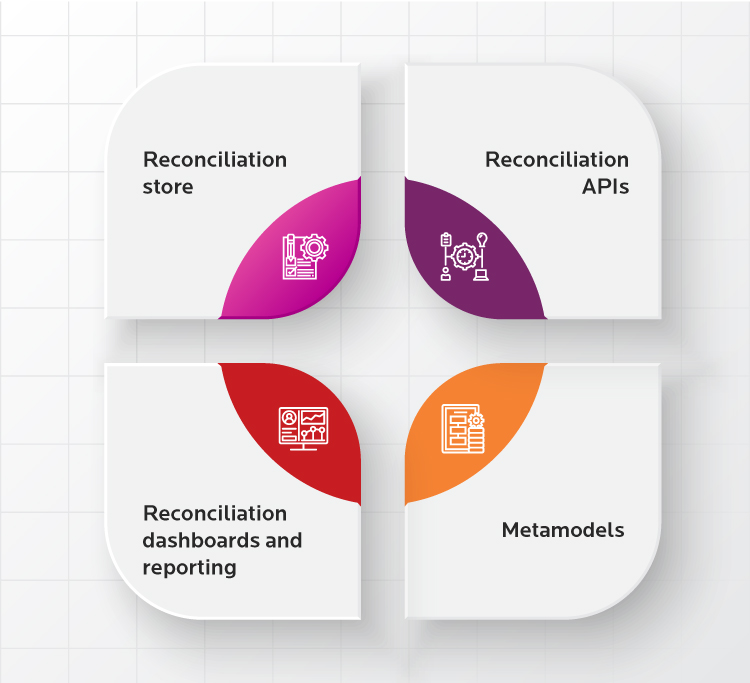How a leading financial services firm built a transactional data reconciliation platform to drive resilience in their business operations
9/11, the sub-prime crisis, and the ongoing COVID-19 pandemic. What’s the common thread that binds these events? Black swan nature, high-systemic risk, and their potential to cripple businesses at a global scale. To withstand events like these, business resilience has been a critical focus for the financial services sector, especially SIFIs (Systemically Important Financial Institution) and SIFMUs (Systemically Important Financial Market Utilities). While there have been significant advances in technology adoption, the vulnerability of the financial services industry against black swan events and systemic risk persists.
Our client is a leading financial services firm. Business resilience is an inherent element of their core business.
To fulfill their vision, they adopted a three-pronged approach to building business resilience that focused on three components – financial resilience, technology resilience, and operational resilience. As part of a broader resilience program, we partnered with the client to help transform their technology resilience.
There were four core elements of this transformation-
- Reduce the interdependency between systems that powered critical business services
- Augment data center and critical operational sites with an alternative option to sustain operations
- Cut potential data loss and maintain data integrity in times of business disruption
- Build self-detection/healing mechanisms to cut downtime and human intervention.
When we started this journey with our client, data reconciliation was a completely manual effort that resulted in sub-optimal performance. Today, our client reconciles over 13 million records with 100% accuracy, completeness, and zero manual intervention, in less than an hour. Let’s look at this transformation journey in detail.
The Challenge
Ensuring regular market operations, preserving completeness and accuracy of transactional data while managing business continuity during a high systemic risk event.
In the case of a high-systemic risk event, many times, there’s a need to activate out-of-region recovery. Several post-trade applications go through a transition phase switching from one data center to another. This switchover has the potential to cause data loss that can go into millions of records. During this transition, the depository must ensure two requirements with 100% precision:
- Completeness of data: no loss of data between the target and source, post-transition
- Accuracy of data: no mismatch of data between the target and source, post-transition
Any delta between the before/after phase of data processing is not permissible. Moreover, there were severe compliance issues if there’s any loss of data.
The Solution
Enable complete and accurate synchronization of transactional data in a BCP active event to drive zero-disruption operations leveraging automation
We worked with the client teams to build a data reconciliation platform that could maintain 100% data integrity. Managing data integrity across regions and within regions meant the implementation of this idea at-scale. We made the full ecosystem of reconciliation applications which had four key components:
- Reconciliation store that assessed the state of information in source and target systems by using business rules. The platform used these rules to check the data’s completeness and accuracy (for data integrity), balance and control (for compliance).
- Reconciliation APIs that helped manage and inquire about the status of reconciliation request
- Metamodels that provided governance of reconciliation rules in source and target data configurations. It also acted as the central repository to define the reconciliation rules for data completeness and accuracy. For metamodels to update the reconciliation store, we developed a metadata bridge
- Reconciliation dashboards that provided reports of all reconciliation services that ran across regions. It helped the auditors run periodic checks to stay compliant. Further, it helped leaders receive alerts in case of escalations or high-risk situations. The teams could now slice and dice the enormous amount of data they had and drive actionable insights.

Figure 1 – Key components of the data reconciliation ecosystem for building business resilience
The Impact
A resilient, secure, and compliant organization
- Resilient and secure: Thanks to data restoration, our client is now more secure within the ecosystem the depository operates. They are now capable of running data reconciliation checks across 13 million records in less than 60 mins. The new system and processes in place have enabled 100% completeness and accuracy of data.
- Compliant: The depository needs to run reconciliation on balance and control to ensure compliance under 3 seconds. The reconciliation engine we have built does it for them in 1.8 seconds. Further, the solution is compliant with the depository scans.
Cover the entire portfolio of applications for the depository to drive resilience at scale through cloud
By adopting the cloud-first approach, we worked with the client to execute this solution at-scale across many regions. As part of the broader modernization program, our client could now host this ‘reconciliation utility’ ‘as a service’. Further, all the applications now had access to use this utility across regions. By enabling cloud-based deployment, this utility became a vehicle to driving resilience at-scale.
Build feedback loops to assess the customer experience and improve the reconciliation process
We are working with the client on developing an interface that will enable them to rate the utility based on their experiences. We built this interface on our proprietary TruCX framework. This allows them to share feedback and suggest potential improvements in service.
Other Case Studies

